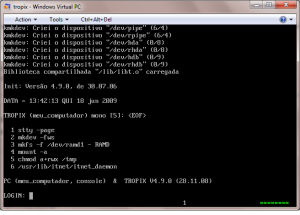
Tropix booted to the login prompt
So I was browsing some stuff, and playing with a few other emulators getting something together when I found an article briefly mentioning TROPIX.
Now TROPIX is interesting as some people from Brazil tried to get a UNIX license in the 1970’s but they were denied. Not to take that as a loss, they bought ‘a’ UNIX system (some kind of v7 box) and built their own OS around the v7 ‘feel’. The result is a multiprocessor, real time UNIX clone written in Portuguese!
Now what is interesting is during the time of TROPIX (the mid 80’s) Brazil was still a dictatorship, and they would refuse to import western things, if there was a local equivalent.. So UNIX vendors never could get a foothold in Brazil because of TROPIX, well back then it was called Plurix. Conversely TROPIX/Plurix never got out because it’s all localalized in Portuguese. Which is too bad, as if it had the ability to spread on the internet I’m pretty sure it would have been popular..
More information can be found here:
However it’s all in Portuguese, so you’ll probably want to use a translator. http://www.google.com/translate is what I’m using.
The latest release was in December of 2008, and added support for USB 2.0 & SATA. So while it may feel dated, it’s being updated to support modern hardware. They even dedicate it to Newton Faller who’s a big name IT wise in Brazil, they even give out awards similar to the Turing award in his honor.
Now onwards to the install!
I am using Qemu as it can emulate the required hardware. Virtual PC will work, but the networking will NOT.
First download the ISO image from here . You’ll need a copy of gzip & tar for whatever your platform is to extract the ISO image. The install is actually somewhat straight forward once I translated the install document, which can be found here.
Basically the following input got me to a working system…
TROPIX CD boot
>
enter
boot>
-f
n
r
s
s
s
s
fdisk>
w
s
q
boot>
-i
login root
password tropix
mkfs /dev/rhda1
mount /dev/hda1 /aroot
cd /usr/etc/install
install
s
hda1
s
n (it’ll copy files)
s
reboot
I’m still trying to figure out the DHCP or the default gateway as neither appear to be working at the moment… Take note that the TCP/IP in TROPIX was written by them, it is *NOT* a 4.3 BSD derived thing. So there is no ifconfig / route / arp commands. Not to be disapointing but it also needs it’s first partition somewhere in the first 512mb as it seems to have some old BIOS booting issues.. Now it could be Qemu, but I’m not sure, a 10gig disk didn’t boot from the HD, although the CD could be make to use the HD for a root…
Right now the only ‘fun’ program to run is coremap & fortune.
But it’s very interesting to see a UNIX developed from another part of the world, and just how similar and different it is… Oh and it’s Si/Non, not YES/NO.

